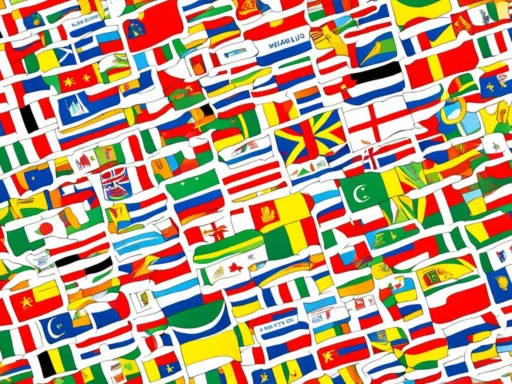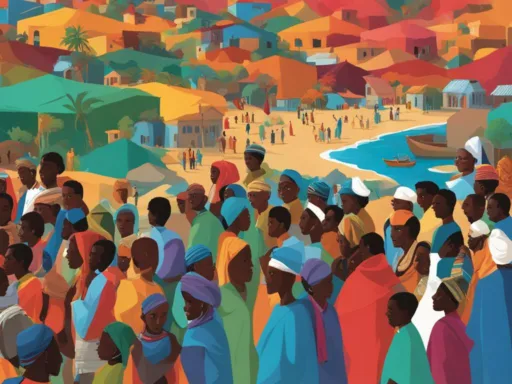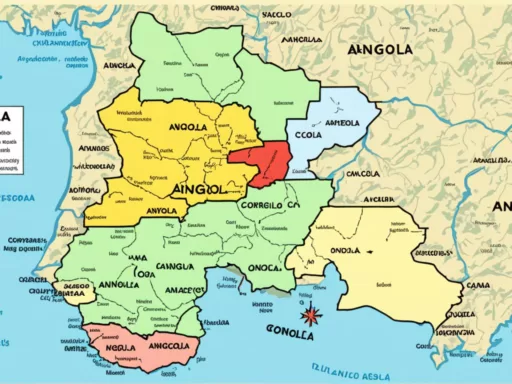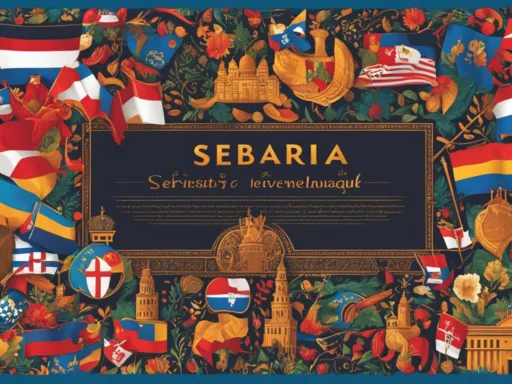Think of Norway, and images of mighty fjords and the aurora borealis might spring to mind. Yet, a striking linguistic fact not often spotlighted is that an astonishing 95% of its population is fluent in not just one, but two official languages. This linguistic proficiency sheds light on the nation’s commitment to cultural and communicative richness. Delving further, the languages spoken in Norway extend beyond the familiar Scandinavian tones of the Norwegian language. Indeed, the land of the midnight sun boasts a rich spectrum of dialects and tongues, weaving a diverse fabric of linguistic heritage that includes the nuanced Sami languages and widespread English proficiency, alongside other minority dialects. This linguistic diversity in Norway sets an example of a society where communication is finely infused with respect and inclusivity—a testament to the value placed on preserving its robust linguistic diversity in Norway.
In Norway, the beauty of language resonates through its scenic landscapes, echoing a history where the official languages in Norway, Norwegian and Sami, harmoniously coexist with an array of immigrant tongues. The linguistic landscape is not just a cultural relic but continues to evolve, mirroring the nation’s progressive outlook and embracing its multi-voiced populace.
Key Takeaways
- Norway’s impressive bilingual fluency in two official languages underscores its high linguistic standards.
- Norwegian and Sami are not just languages but represent the country’s commitment to preserving cultural identities.
- English is widely spoken, making Norway an accessible destination for international visitors and students.
- The presence of minority and immigrant languages enriches the Norwegian linguistic landscape, reflecting societal openness.
- Norway’s progressive linguistic policies promote learning and integration, ensuring a multilingual and inclusive society.
- The nation’s linguistic capabilities span from the rich native dialects of rural communities to global English proficiency.
- Embracing linguistic diversity is integral to Norway’s cultural ethos, educational frameworks, and social policies.
The Linguistic Landscape of Norway: A Glimpse Into Diversity
The northern expanse of Scandinavia, with Norway at its heart, hosts a rich and variegated linguistic landscape, reflective of its historical layers and cultural dimensions. From the rugged coastlines to the aurora-lit skies, language echoes the nation’s dynamic heritage and inclusive ethos.
Norwegian – The Dominant Voice
With approximately 95% of Norway’s population conversing in the dominant Norwegian language, it anchors itself as the pivotal medium for daily interaction and social fabric. Rooted in Old Norse, Norwegian uniquely splits into two recognized forms: Bokmål and Nynorsk. These forms evolved amidst a historic tug-of-war for linguistic identity during the Språkstriden, a period of national awakening and resistance to Danish dominance.
Sami Languages – The Indigenous Echoes
Indigenous Sami languages resonate the depth of Norway’s cultural spirit. Speaking volumes of the country’s dedication to diversity, these languages retain constitutional protection and cultural reverence. Among them, North Sami leads as the most widely spoken, encapsulating the voices of the indigenous peoples strewn across Norway’s vast northern reaches.
English in Norway – A Lingua Franca
Complementing the domestic tongues, English unfolds across Norway like a global tapestry, with English proficiency in Norway being impressively high. School curriculums and societal values embed English firmly within the Norwegian psyche, enabling seamless communication in this burgeoning lingua franca and propelling Norway onto a stage of international discourse.
Delving into Norwegian: Bokmål vs Nynorsk
Norwegian dialects are as varied as the picturesque landscapes of Norway itself. The beautiful texture of the language is most vividly seen in the comparison between Bokmål Norwegian and Nynorsk Norwegian. To understand the language differences in Norway, one must dive into the stories and structures of these two official writing systems.
Bokmål, which means “book language,” is often associated with urban regions and is used by the majority of the Norwegian population. It represents a Norwegianized version of the Danish language, which was the standard written form during centuries of Danish rule. Bokmål has been reformed over the years, inching closer to the local speech in an effort to capture an authentic Norwegian voice. Despite its proximity to spoken Norwegian, it still retains many of the Danish influences.
On the other hand, Nynorsk, meaning “new Norwegian,” is the linguistic tribute to Norway’s rural heartlands. This form was developed by Ivar Aasen in the 19th century, aiming to reflect a more pure and indigenous Norwegian ethos, based on the different spoken dialects found in the western and central parts of Norway. Unlike Bokmål, Nynorsk arose from a meticulously gathered corpus of the country’s rural dialects.
Together, Bokmål and Nynorsk encapsulate the ongoing dialogue between Norway’s urban sophistication and rural authenticity. While Bokmål is undeniably dominant, Nynorsk commands a dedicated following, ensuring that the diversity of Norwegian dialects continues to flourish.
- Urban vs. Rural: Bokmål’s roots in city life contrast with Nynorsk’s rural origins.
- Språkstriden: The language strife in Norwegian history reflects the nation’s aspirations for a distinct linguistic identity.
- Written Standards: Despite spoken variations, Bokmål and Nynorsk provide cohesion as written standards.
- Educational Presence: Both forms are taught in schools, perpetuating their use in future generations.
“While Bokmål is the preferred written language of most Norwegians, Nynorsk remains a significant emblem of the nation’s commitment to its linguistic diversity.”
The preservation of language is akin to the preservation of culture, and Norway’s stance on sustaining both Bokmål and Nynorsk is a testament to its respect for tradition as well as its forward-looking approach to inclusion and diversity. Understanding the nuances between these forms is to grasp a deeper sense of Norwegian identity itself.

Minority and Indigenous Languages in Norway
The exploration of Norway’s linguistic panorama is incomplete without acknowledging the rich tapestry woven by its minority and indigenous languages. These languages are not merely means of communication; they are the lifeblood of cultures, emblems of history, and pillars of identity for many minorities in the region.
Norway’s persistent efforts to preserve the depth and breadth of its linguistic diversity is a testament to the country’s inclusive cultural policy. The indigenous languages of Norway, especially those spoken by the Sami people, and the Kven language are integral to the nation’s cultural fabric. The Sami languages, in particular, are under constitutional protection, highlighting their significance in the articulation of national cultural identity.
The Role of Sami in Norwegian Culture
The Sami people’s languages represent the essence of resilience and cultural richness in Norway. Notably, the North Sami dialect is the most widely spoken, charting a course for the perpetuation of Sami cultural significance in both Norway and the wider Scandinavian region. The dedication to maintain these languages goes beyond mere words, reflecting a commitment to honoring the past and nurturing the future of Sami communities.

The Sami languages manifest in various forms, from traditional joik singing to reindeer herding terminologies, offering a window into a way of life that is intricately linked to the Arctic landscape. The unwavering respect for the Sami cultural significance serves as both a bridge to history and a gateway to understanding the diversity of human expression.
Kven – Norway’s Finnic Language Heritage
On the shores of the Norwegian fjords, nestled in the northeastern part of the country, the Kven language survives as a vibrant fragment of Norway’s linguistic puzzle. A descendant of Finno-Ugric roots, the Kven language connects Norway to the broader Finnic language heritage, shared by neighboring Finland.
The Kven community’s journey is one marked by perseverance, as they have sought to maintain their language amidst changing political landscapes and cultural dynamics. Despite being a minority language, Kven flourishes in areas such as the Troms and Finnmark region, bowing neither to time nor to assimilation-driven challenges.
In summary, the narratives of the indigenous languages in Norway, particularly Sami and Kven, are chapters of a larger story about cultural determination and identity preservation. They remind us of the unique voices that contribute to the symphony of human communication and the importance of embracing linguistic diversity as a cornerstone of society.
Norway’s Multilingual Society: Immigrant Languages
Norway, known for its majestic landscapes and rich cultural heritage, is also a vibrant multilingual society. The diversity of languages spoken within the nation is a testament to its open and inclusive ethos. A significant contribution to this linguistic diversity comes from the various immigrant languages that enrich the Norwegian linguistic fabric, making it both diverse and dynamic.
Languages from across the globe are spoken daily by Norway’s residents, painting a picture of a country deeply interconnected with the wider world. From the bustling city of Oslo to the serene coastlines of the North, the mosaic of languages speaks volumes of Norway’s adaptability and inclusivity. These immigrant languages in Norway are not just mere methods of communication; they are integral to the identity and culture of the immigrant communities. They add substantial depth to Norway’s linguistic diversity, weaving through the social, economic, and cultural tapestry of the nation.
- Polish
- Lithuanian
- Somali
- Arabic
- Many others contributing to the non-native languages in Norway

These languages are supported through various governmental and community initiatives that aim to promote multiculturalism and mutual understanding. As more people from different backgrounds call Norway their home, the importance of language learning and cultural exchange becomes paramount. Both the Norwegian society and its international residents reap the benefits of such a rich linguistic environment.
In essence, Norway’s openness to a multilingual society not only enhances its own cultural landscape but also offers a model for other nations to follow. It stands as a beacon of successful integration, showing how a society can flourish by embracing, celebrating, and utilizing the vast array of languages brought by its people from every corner of the globe.
languages spoken Norway: Understanding the Official Tongues
Delving into the official languages in Norway offers a window into the nation’s efforts to maintain and promote linguistic variety. The Norwegian language, prevalent in both the Bokmål and Nynorsk forms, serves as a backbone for cultural and communicative exchanges across the country. With substantial backing through language policies, Norway skillfully balances the maintenance of its linguistic heritage with contemporary needs.
Language is the road map of a culture. It tells you where its people come from and where they are going. – Rita Mae Brown
To truly grasp the Norwegian language prevalence, it is paramount to understand the intricacies of these official tongues. While Sami languages carry equal status, their use is predominantly within the northern regions, providing a rich tapestry of linguistic diversity that mirrors the nation’s cultural mosaic.
Here’s an overview of the language landscape in Norway, which reflects the country’s inclusive approach:
| Language | Prevalence | Usage Context |
|---|---|---|
| Bokmål Norwegian | Widespread | Mainstream education, media, and administration |
| Nynorsk Norwegian | Regional | Western Norway communities, cultural expressions |
| Sami Languages | Regional | Indigenous communities, Sami Parliament, local administration |
Norway’s language policies are indicative of its dedication to not only conserving these languages but also ensuring understanding Norwegian is accessible to all citizens. Whether it’s through public broadcasts in both Bokmål and Nynorsk or the implementation of language education in schools, these policies represent an environment that treasures inclusivity and comprehension for every Norwegian speaker.
- Comprehensive education in the official languages ensures that citizens are proficient, no matter their dialect.
- State-funded initiatives are in place to support Sami language preservation and revitalization.
- Language courses tailored for both Bokmål and Nynorsk speakers help to promote mutual understanding and respect.
Moving forward, Norway continues to adapt its language policies reflecting the dynamic nature of its sociolinguistic fabric, ensuring that the official languages in Norway remain vibrant elements of daily life.
Learning the Language: Norwegian Education and Integration
Aiming to construct a society that is both inclusive and diverse, Norwegian language education serves as a vital stepping stone towards integrating newcomers. Tailored language courses in Norway are pivotal for fresh immigrants, allowing them to quickly adapt to their new surroundings while fostering an understanding of local customs and everyday social interaction. In this section, we delve into the educational frameworks and resources that make learning Norwegian an accessible and enriching experience for all.
Norwegian for Newcomers: Language Courses and Resources
New residents in Norway can take advantage of a wealth of structured language courses that cater to various proficiency levels and learning styles. From classroom-based teaching to online modules, these learning platforms are not only about grasping the language but also understanding the societal norms of Norwegian culture. With user-friendly textbooks and digital tools, language acquisition is made efficient for a smooth transition into Norwegian social life.
Educational Policies Promoting Language Diversity
Norway’s integration language policies actively promote linguistic diversity, acknowledging the multiple benefits it brings to both individuals and the community at large. These policies encompass a regulatory framework dedicated to ensuring language courses are of high quality and accessible to all, thereby nurturing an environment where both Bokmål and Nynorsk, as well as other minority and immigrant languages, are valued and upheld.
| Language Policy Element | Description | Impact |
|---|---|---|
| Mandatory Language Education | All new immigrants are required to complete a certain number of hours in Norwegian language learning and social studies. | Improves basic language proficiency, crucial for work and social integration. |
| Diverse Learning Materials | Provision of learning materials in multiple languages to cater to diverse backgrounds. | Supports learners of different linguistic backgrounds and promotes inclusivity. |
| Support for Minority Languages | Promotion of Sami and other indigenous languages in schools and public services. | Preserves the linguistic heritage and strengthens cultural identity. |
| Certification and Incentives | Achievement certificates and potential incentives for successful completion of language courses. | Encourages continued language learning and acknowledges the effort put in by learners. |
Norwegian, English, and Beyond: Language Proficiency in Norway
The symphony of languages spoken in Norway is a reflection of its world-class language education system and its engagement with global culture. With an impressive scoring in the EF English Proficiency Index, Norwegian citizens showcase their superior English skills Norwegians are known for. This is not confined to the younger generation alone; the proficiency is widespread among various demographic groups, representing the nation’s commitment to multilingual proficiency.
Such skills are underpinned by Norway’s educational policies, which prioritize language as a core part of education. This solid foundation allows for Norwegians’ highly regarded fluency in English, making them equally adept in both local and international spheres of communication. A closer look reveals a nation where language proficiency in Norway extends to multiple languages, facilitated by initiatives in language education Norway to encourage the learning of other foreign languages as well.
| Age Group | English Proficiency Level | Additional Languages Known |
|---|---|---|
| 18-24 | Very High | 1-2 (Commonly German, Spanish, or French) |
| 25-44 | High | 1 (Typically German or Spanish) |
| 45-64 | Moderate to High | 0-1 (Often German) |
| 65+ | Moderate | 0-1 (Various, depending on individual interest) |
It’s noteworthy that the nation’s language competence not only enhances internal communication but also positions its population advantageously in the global arena. Norway’s model of language education thus serves as a paragon, underscoring the benefits of nurturing a society that is not only bilingual but also proficient in multiple tongues.
Cultural Expressions Through Language in Norway
Language is the vibrant thread that weaves together the rich tapestry of Norway’s cultural identity. Not only serving as a utilitarian tool for daily communication, it also resonates with the deep cultural expressions that form the bedrock of Norway’s unique heritage. Through various forms, from the spoken word to the power of the written narrative, Norwegian language and culture echo each other’s sentiments, all while celebrating the country’s divergent voices.
Language and Identity Among the Sami
The Sami language identity is a profound example of language as much more than a mere method of communication—it is the soul of the Sami community. Across the snowy expanses and within the rich history of Norway, the Sami people have used language to articulate their cultural expressions, traditions, and values. Their distinct tongues echo through the fjords and serve as a testament to their enduring cultural legacy.
Literature and Media: Representing Norway’s Linguistic Diversity
Norwegian literature offers an immersive journey into the depths of Norway’s linguistic landscape, unfolding stories that have been shaped by the very mountains and seas that define the Norwegian domain. Literary giants such as Henrik Ibsen and Sigrid Undset have penned classics in Norwegian, which continue to influence readers globally. Simultaneously, media linguistic representation in Norway paints a dynamic portrait of society, capturing its wondrous variety and channeling a multitude of linguistic voices into a single, harmonious chorus.
| Media Outlet | Linguistic Representation | Content Type |
|---|---|---|
| NRK | Multilingual Broadcasting | News, Entertainment |
| Aftenposten | Norwegian Language Focus | Print and Digital News |
| Sámi Radio | Sami Languages | Cultural Programming |
| Literary Festivals | Diverse Linguistic Participation | Workshops, Readings, Discussions |
As Norway’s society evolves, the steadfast bond between cultural expressions and language remains immutable, with the country’s spirit ever-reflected in the Sami language, Norwegian literature, and a media landscape that champions linguistic diversity.
Conclusion
The landscape of linguistic heritage Norway is as multifaceted and remarkable as its verdant fjords and aurora-lit skies. This Scandinavian nation illustrates a profound reverence for language as the bedrock of cultural identity and societal enrichment. At its heart lies the Norwegian language conclusion—a tapestry woven from the threads of Bokmål, Nynorsk, and the enduring voices of the indigenous Sami, enriched by the mellifluous rhythms of minority and immigrant dialects.
By embracing language diversity Norway sets a global paradigm, demonstrating how a country can honor its historic linguistics while remaining agile and forward-looking. The adoption and integration of English signify not just practical communication needs, but a willingness to engage actively in global discourse. Education systems and cultural institutions alike champion the sustenance of a diverse linguistic environment, one where each linguistic hue finds its space and resonance.
As we contemplate Norway’s language future, we see not a monochrome spectrum but a kaleidoscope of possibilities. Norway continues to fortify its legacy, pioneering in preserving linguistic variety as an asset rather than a challenge. This forward momentum promises to cultivate an ever-more inclusive and intellectually robust Norwegian society, poised to thrive in an increasingly interconnected world.






